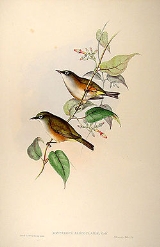
White-chested White-eye
Encyclopedia
The White-chested White-eye (Zosterops albogularis) also known as White-breasted White-eye or Norfolk White-eye is a passerine from the family Zosteropidae
. It is endemic to Norfolk Island
between New Caledonia
and New Zealand
and it is regarded as one of the rarest birds in the world. Since 2000 the Australian government has considered the species extinct.
(Zosterops lateralis) became naturalized on Norfolk Island. It displaced the White-chested White-eye from its breeding range. From the 1940s rats destroyed the nests and clearing of the forests led to a severe decline in the population to only 50 individuals in 1962. In 1986 the Norfolk Island National Park was established to save this bird from extinction, but because of the fluctuation of this species, surveys often remained unsuccessful. In 1978 only four individuals where monitored, a sighting in 2000 resulted in one individual; bird watchers claimed to have seen the bird in 2005, however official surveys have not recorded the species since 1980. A predator-exclusion fence was built around the last remained habitat in the Norfolk Island National Park
A survey by ornithologist Guy Dutson
in 2009 failed to find any individuals
White-eye
White-eye can refer to:*White-eye , a large family of birds.*White-eye , a species of fish.*White-eye mutation, a mutation in Drosophila melanogaster linked to the X chromosome, found by reciprocal cross breeding experiments in 1906.*A lioness member of the Marsh Pride of lions that have featured...
. It is endemic to Norfolk Island
Norfolk Island
Norfolk Island is a small island in the Pacific Ocean located between Australia, New Zealand and New Caledonia. The island is part of the Commonwealth of Australia, but it enjoys a large degree of self-governance...
between New Caledonia
New Caledonia
New Caledonia is a special collectivity of France located in the southwest Pacific Ocean, east of Australia and about from Metropolitan France. The archipelago, part of the Melanesia subregion, includes the main island of Grande Terre, the Loyalty Islands, the Belep archipelago, the Isle of...
and New Zealand
New Zealand
New Zealand is an island country in the south-western Pacific Ocean comprising two main landmasses and numerous smaller islands. The country is situated some east of Australia across the Tasman Sea, and roughly south of the Pacific island nations of New Caledonia, Fiji, and Tonga...
and it is regarded as one of the rarest birds in the world. Since 2000 the Australian government has considered the species extinct.
Description
It reaches a length up to fourteen centimetres and therefore it is one of the largest white-eyes. The wingspan is 7.5 cm and the weight is about 30 grams. Its appearance is characterized by a pale green head, an olive green coloured neck and white throat and belly parts. A further feature is a conspicuous eye ring of white feathers. Males and females are coloured similarly. Its diet consists of fruits, berries, nectar, and insects. Its only habitat is a 5 km² large forested area around Mount Pitt on Norfolk Island where it lives solitary. In the breeding season from October to December the couple build a cup-shaped nest in which two white eggs are laid. The incubation time lasts eleven days and another eleven days later the juveniles became fully fledged.Threats
The largest threats are habitat destruction and invasive species. The decline of the White-chested White-eye began as the introduced SilvereyeSilvereye
The Silvereye or Wax-eye is a very small passerine bird native to Australia, New Zealand and the south-west Pacific islands of Lord Howe, New Caledonia, Loyalty Islands, Vanuatu, and Fiji...
(Zosterops lateralis) became naturalized on Norfolk Island. It displaced the White-chested White-eye from its breeding range. From the 1940s rats destroyed the nests and clearing of the forests led to a severe decline in the population to only 50 individuals in 1962. In 1986 the Norfolk Island National Park was established to save this bird from extinction, but because of the fluctuation of this species, surveys often remained unsuccessful. In 1978 only four individuals where monitored, a sighting in 2000 resulted in one individual; bird watchers claimed to have seen the bird in 2005, however official surveys have not recorded the species since 1980. A predator-exclusion fence was built around the last remained habitat in the Norfolk Island National Park
Norfolk Island National Park
Norfolk Island National Park is a protected area of 6.50 km² established in 1984 and managed by the Commonwealth of Australia. It comprises two sections, the Mount Pitt section on Norfolk Island in the South Pacific Ocean with an area of 4.60 km² and the neighbouring 1.90 km² Phillip Island, as...
A survey by ornithologist Guy Dutson
Guy Dutson
Dr Guy Dutson is a British-born veterinarian, ornithologist and a leader of birding tours, who is a world authority on the birds of the south-west Pacific region. He has rediscovered or described several bird species....
in 2009 failed to find any individuals

